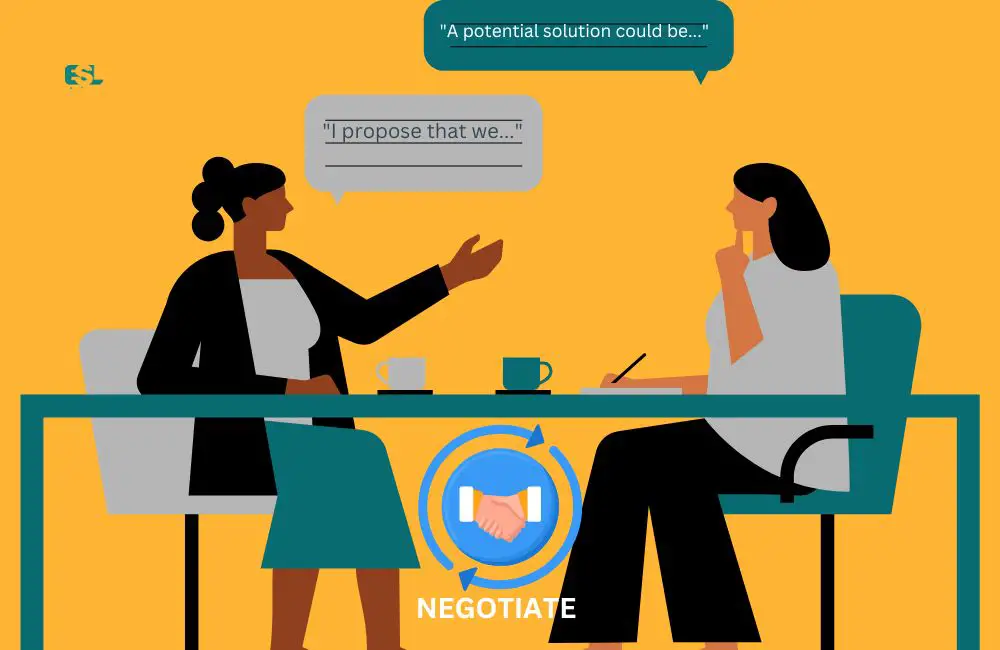This article covers the following areas –
- What Is Negotiation?
- Why Do You Need to Learn Negotiating in English?
- Steps to Successful Negotiation in English: Complete Guide
- General English Phrases/Expressions to Negotiate
- Final Words
Negotiation is a critical skill in any language. When it comes to English, a non-native speaker may face several challenges. However, with a few key strategies, you can master the art of negotiation. In this post, I’ll guide you through the process of successful negotiation in English, breaking it down into simple steps.
To negotiate in English successfully, employ clear communication, active listening, and assertive yet respectful language. Understand cultural nuances, avoid complex jargon, use polite phrases like “I believe”, and “Could we consider,” and ask open-ended questions for clarity.
Interested in further details? Continue reading to delve into comprehensive strategies, practical examples, and cultural considerations to enhance your English negotiation skills. Discover how to convey your viewpoints persuasively without compromising respect or mutual understanding.
What Is Negotiation?
Negotiation is not merely a discussion between parties; it’s a strategic process that requires empathy, understanding, communication skills, and the ability to find a common solution. It’s a skill that transcends all areas of life, from personal relationships to business transactions.
In this context, negotiation in English, the lingua franca of our modern world, gains even more significance. It empowers individuals to communicate and negotiate effectively across borders, cultures, and business environments. This section of the article will dive deeper into the basics of negotiation and its importance when conducted in English.
The Basics of Negotiation
Negotiation is an everyday occurrence that we engage in both consciously and subconsciously. Negotiation is omnipresent, from deciding on a place to dine out with friends to more complex negotiations like business contracts or diplomatic agreements. It involves two or more parties with different interests and needs trying to reach a mutually beneficial agreement.
Understanding the fundamental aspects of negotiation is critical to carrying it out effectively. The first step is understanding your own needs and interests. What are your non-negotiables? What aspects are you willing to compromise on? Understanding the other party’s needs and wants is equally important.
Identifying common ground is another crucial element. Finding shared interests or benefits can create a cooperative atmosphere rather than a combative one. It fosters mutual respect and understanding, paving the way for fruitful discussions.
Finally, the ultimate goal of negotiation is to reach a solution that satisfies all parties involved. This may involve compromise, creative problem-solving, and mutual concessions.
Types of Negotiation
Negotiation can be broadly categorized into two types:
- Distributive Negotiation: Also known as “win-lose” or “zero-sum” negotiation, this involves a fixed amount of value that needs to be divided between the parties. It’s often competitive, as one party’s gain signifies the other’s loss.
- Integrative Negotiation: In this “win-win” negotiation, parties collaborate to find a solution that benefits everyone. The aim is to expand the value on the table so all parties walk away feeling successful.
Knowing which type of negotiation you’re engaged in can significantly influence your strategy and approach.
Why Do You Need to Learn Negotiating in English?
In a globally interconnected world, English has emerged as a universal medium of communication. It’s the primary language of business, diplomacy, and internet content, among other areas. Therefore, the ability to negotiate successfully in English is a highly valuable skill.
There’s no denying that English has become the lingua franca of international business. Whether you’re closing a deal with an overseas client or working in a multicultural team, effective negotiation in English is critical.
Moreover, it’s not just in the business sphere that English negotiation skills come into play. For non-native speakers, mastering negotiation in English can help bridge cultural gaps, enhance international relations, and even make travel experiences smoother and more enjoyable.
English Negotiation in Different Cultures
Cultural nuances can significantly influence the way negotiations are conducted. For instance, in some cultures, direct confrontation or disagreement might be considered rude, while in others, it’s seen as a sign of honesty. A deep understanding of these cultural differences is vital when negotiating with individuals from different cultural backgrounds in English.
Here are a few general examples:
- Western cultures (US, Canada, Western Europe): Generally prefer a direct approach in negotiation. Assertiveness and straightforwardness are valued.
- Eastern cultures (Japan, China, Korea): Often value respect, harmony, and indirect communication. They may prefer subtle hints over direct confrontation.
- Middle Eastern cultures: Negotiation is often seen as a social activity. Building relationships and trust is usually an important part of the process.
Understanding these nuances can improve communication, prevent misunderstandings, and ultimately contribute to successful negotiations.
Steps to Successful Negotiation in English: Complete Guide
Embarking on a negotiation journey requires careful planning, strategic thinking, and effective communication. The process is akin to running a marathon, not a sprint, requiring endurance, patience, and perseverance.
In English, the challenge may seem more daunting for non-native speakers, yet the core principles of negotiation remain the same. This section will provide a comprehensive, step-by-step guide to mastering negotiation in English, covering everything from initial preparation to reaching a consensus.
Step 1: Preparation is Key
Successful negotiation is built on a foundation of thorough preparation. This involves understanding your objective and comprehensively researching the topic and the other party. Preparation ensures you enter the negotiation with a clear strategy and all the necessary information to support your position.
Understand Your Objective
The first step in any negotiation is to establish your objectives. This is the “why” of your negotiation. What are you hoping to achieve? What is your best possible outcome, and what is your minimum acceptable outcome?
By identifying these benchmarks, you can navigate the negotiation process with a clear goal in mind. Here are a few examples of objectives that might come up in a typical negotiation:
- Our primary objective is to agree on a price that aligns with our budget.
- We hope to secure a delivery schedule that meets our production timeline.
- My goal in this negotiation is to achieve a flexible work schedule.
- We aim to establish a long-term partnership that benefits both parties.
- Our main aim is to finalize a mutually beneficial delivery schedule.
- We are seeking a robust and reliable service contract.
- Our negotiation objective is to reach an agreement on the project timeline.
Research Thoroughly
Once you’ve set your objectives, the next step is research. This involves gathering all relevant information about the negotiation topic and understanding the other party’s potential interests and needs. To give you a better idea of what this could entail, consider the following examples of information you might want to gather:
- We have researched our supplier’s background, understanding their production capabilities and financial standing.
- I’ve studied the market prices to ensure our pricing request is reasonable.
- We’ve familiarized ourselves with the company’s culture to navigate the negotiation effectively.
- I’ve looked into our past agreements to identify patterns and trends.
- We’ve reviewed your product specifications and compared them to our needs.
- I’ve analyzed your delivery times and found that they can align with our schedule.
- We’ve examined your service packages and identified the one that best suits our requirements.
Step 2: Engage in the Conversation
The next phase involves engaging actively in the conversation. A positive start can set the tone for the rest of the negotiation. It’s also important to use clear, simple language to ensure your points are understood correctly.
Start Positively
Setting the right tone from the beginning is crucial. Start with a positive, respectful greeting and express optimism about the negotiation outcome. This not only puts everyone at ease but also fosters a collaborative environment. Here are some sentences you can use to start the conversation on a positive note:
- It was great to meet with you today. I’m optimistic we can find common ground.
- I appreciate your time today. I believe we can arrive at a beneficial agreement.
- I’m looking forward to our discussion and finding a solution that works for both of us.
- Thank you for meeting with us today. I trust we can align our goals effectively.
- It’s a pleasure to be here. I’m hopeful we can reach a satisfactory agreement.
- We appreciate the opportunity to negotiate this matter with you. We’re confident we can find a middle ground.
Use Clear and Simple Language
Using clear, simple language is vital, especially for non-native English speakers. Avoid jargon and complex phrases that might confuse the other party. Speak slowly and clearly to ensure you’re understood. Here are some examples of how to communicate your points simply and clearly:
- I propose we consider an alternative solution.
- From our perspective, we need a more flexible payment plan.
- We believe a partnership would be beneficial for both of us.
- We suggest adjusting the delivery schedule to better suit our needs.
- It seems to us that a longer contract term could offer more stability.
- We’d like to discuss the possibility of a volume discount.
Step 3: Express Your Needs and Listen
Negotiation is a two-way street. It involves expressing your needs clearly and assertively while also practicing active listening to understand the other party’s perspective.
Be Assertive
Being assertive means expressing your needs and wants clearly and confidently without being aggressive or disrespectful. It’s important to stand up for your interests while respecting the other party’s interests. Here are a few examples of how you might assert your needs in a negotiation:
- We require a delivery schedule that aligns with our production timeline.
- My need is to have clarity about the job responsibilities.
- It’s crucial for us to establish a long-term contract for stability.
- We insist on a clear and transparent pricing structure.
- Our requirement is for the service to be available 24/7.
- We need to agree on the termination clauses of the contract.
- My key requirement is a commitment to ongoing training and support.
Practice Active Listening
Active listening is more than just hearing the other party’s words. It involves understanding, interpreting, and responding to their message. Demonstrating your engagement and interest in their viewpoint can build rapport and trust. Here are some ways to show that you’re practicing active listening:
- I understand your concern about the delivery timelines.
- I hear your need for a more robust communication system.
- Your point about the need for quality assurance resonates with us.
- I appreciate your perspective on the contract terms.
- Your suggestion for a phased payment plan makes sense.
- I hear you prefer a shorter contract, and we can discuss that.
- Your emphasis on the need for regular updates is something we can align with.
Step 4: Negotiate and Reach a Consensus
The final phase of the negotiation process involves finding common ground, suggesting solutions, and being prepared to compromise to reach a consensus that benefits all parties involved.
Find Common Ground
Finding areas of agreement can create a sense of unity and cooperation. It makes the negotiation process smoother and paves the way for resolving disagreements. Consider these examples of how you might express common ground:
- We both agree on the importance of a sustainable partnership.
- We share the same goal of improving service delivery.
- It seems we both value transparent and regular communication.
- We’re in agreement that quality assurance is vital.
- Both parties seem to prioritize a timely delivery schedule.
- We share a commitment to ethical business practices.
- It’s clear we both view customer satisfaction as a key goal.
Suggest Solutions
Proposing solutions that meet the needs of all parties is the key to a successful negotiation outcome. Your proposed solutions should reflect your understanding of the other party’s needs and interests. Below are some examples of how you might propose solutions:
- Considering our mutual need for stability, how about a two-year contract?
- Based on our shared goal of cost reduction, we propose bulk purchasing.
- In light of your concerns about delivery, we suggest prioritizing key products.
- Given our common goal of quality, we propose regular quality checks.
- Acknowledging your need for flexibility, we suggest a variable pricing structure.
- Understanding your preference for prompt service, we offer a 24/7 support line.
- Recognizing our shared commitment to sustainability, we propose a green supply chain.
Be Prepared to Compromise
Being prepared to make concessions is part of any negotiation. It’s rare to achieve everything you initially wanted. However, a successful compromise leads to a solution that everyone can live with. Here are some examples of compromise language you might use:
- While we prefer a lower price, we’re willing to accept your offer if the quality is guaranteed.
- We can agree to a shorter contract duration if it includes an option for renewal.
- While we want weekly deliveries, we’re willing to consider bi-weekly if it ensures product availability.
- Though we’d prefer earlier delivery times, we can adjust if it means guaranteed stock.
- We’re willing to pay a higher rate if it includes comprehensive after-sales support.
- While we had hoped for a longer contract, we’re open to renegotiation after a year.
- Even though our preference was for a local supplier, we can accept this if transportation is assured.
General English Phrases/Expressions to Negotiate
When negotiating in English, a comprehensive understanding of common phrases can dramatically influence the outcome. The right phrase can communicate your intentions, facilitate mutual understanding, and help steer the conversation toward a satisfactory resolution.
This section delves into effective English phrases to use when initiating the negotiation, stating your needs, proposing a solution, or seeking a compromise. Mastering these phrases can help non-native English speakers negotiate with confidence and ease.
To Begin the Conversation
The beginning of a negotiation sets the tone for the entire process. Opening the conversation on a positive, constructive note can influence the direction of the discussion. Here are some common phrases that can be used to start the negotiation on the right foot:
- I hope we can come to a mutually beneficial agreement today.
- I am looking forward to our productive discussion.
- Let’s aim to find a solution that works for both parties.
- I appreciate the opportunity to discuss this matter with you.
- Let’s work towards an agreement that respects our mutual interests.
- I believe we can resolve any differences in a constructive manner.
- I trust that we can find a middle ground through this discussion.
- It’s great to have the chance to negotiate this matter with you.
- I am confident that we can reach a compromise that suits us both.
- I anticipate a fruitful discussion where we can align our goals.
- Let’s explore opportunities that can lead to shared benefits.
- I am hopeful that we can settle on an agreement that meets our needs.
- Let’s strive to build a partnership that values our mutual interests.
- I am eager to negotiate a deal that is fair to both of us.
- Let’s find a resolution that celebrates our shared objectives.
To State Your Needs
Clearly stating your needs is an integral part of the negotiation. It’s crucial to communicate your requirements in a manner that respects the other party’s interests. Here are 15 phrases that can be used to effectively express your needs:
- I believe that for us to proceed, we require…
- Our main need is…
- It’s critical for us that…
- Our primary concern is…
- It’s essential for us to…
- We are particularly interested in…
- We need to ensure that…
- Our key requirement is…
- It’s vital for our operations that…
- Our main expectation is…
- What’s most important for us is…
- The deal should ideally…
- We would strongly prefer…
- It’s indispensable for us to…
- Our ultimate goal is…
To Propose a Solution
Proposing solutions is where negotiation truly takes shape. It’s about putting forth suggestions that reflect your understanding of the other party’s needs and your own. Here are some phrases that can be used to propose solutions:
- How about we consider…
- I suggest we explore the possibility of…
- It could be beneficial if we…
- Let’s contemplate the idea of…
- We could possibly…
- What if we try…
- Could we look at…
- An interesting approach could be to…
- We might want to think about…
- A potential solution could be…
- I propose that we…
- It might be advantageous to…
- We should give some thought to…
- We might find it useful to…
- Perhaps we could…
To Compromise
Finally, finding a middle ground is often the most challenging and crucial part of negotiation. Here are some phrases that can be used to express willingness to compromise:
- I’m willing to accept this if we can agree on…
- We can compromise on this point provided that…
- We can consider your suggestion if we…
- I can agree to this under the condition that…
- I am open to this idea if we can ensure that…
- I can live with this proposal if we can manage to…
- We can accept these terms if you agree to…
- I can meet you halfway if we…
- We can accommodate this request if…
- We can be flexible about this issue if…
- I can adapt to this condition provided we…
- We are able to concede this point if we can come to terms on…
- We can yield on this matter if it means that…
- We’re willing to bend on this point if we can settle on…
- I can agree to these terms if we are aligned on…
Final Words
Negotiating in English can be a challenging but rewarding skill. With thorough preparation, clear communication, and an understanding of the other party’s needs, you can navigate your way toward a successful agreement. Remember, practice makes perfect. Keep engaging in negotiations to enhance your skills and confidence.
Negotiation is not a battle but a process of finding a solution that benefits all parties. With this guide, you’re now ready to venture into your next English negotiation with greater confidence and competence. Good luck!






